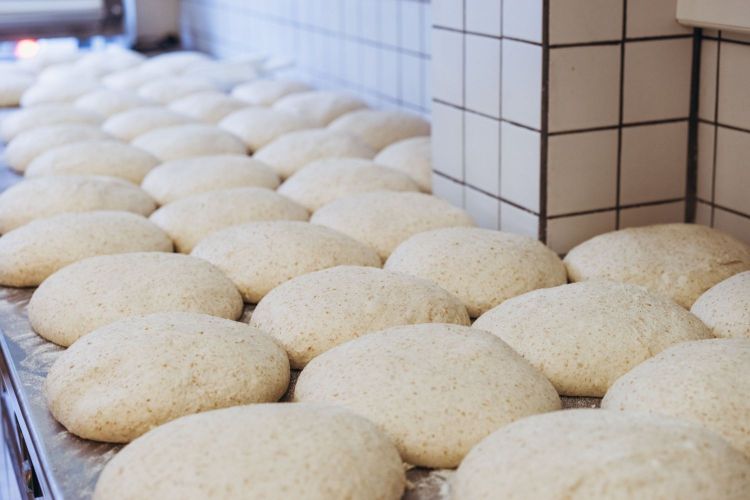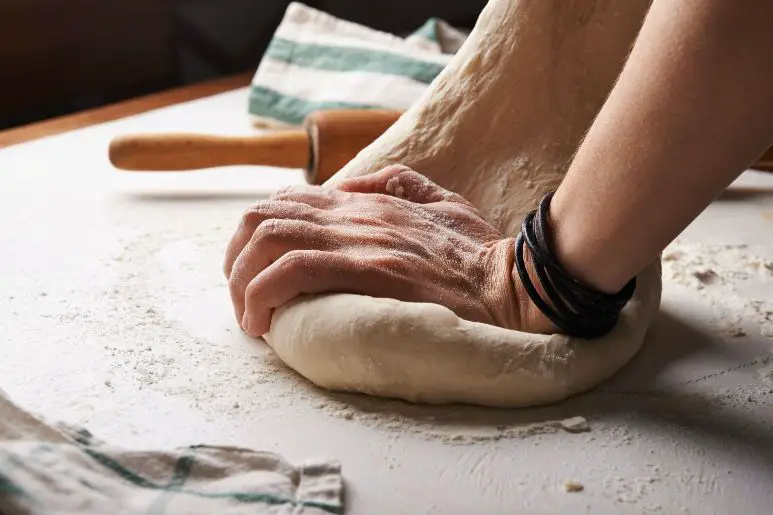Baking bread is an age-old culinary tradition that combines science and artistry in a delightful marriage.
Among the various stages of bread-making, the process of proofing stands out as a pivotal step that significantly impacts the texture, flavor and overall quality of the final product.
But, Have you ever wondered why do we proof bread twice?
In this article, I’ll reveal the 4 reasons behind this technique, and the science that drives it, also I’ll share what is the ideal temperature range for proofing. Let’s dive in.
Why Do We Proof Bread Twice – Revealed
Proofing bread twice, also known as “double proofing” or “two-stage fermentation,” is an important step in the bread-making process that enhances the final product’s flavor, texture, and overall quality.
The two proofing stages involve allowing the dough to rise twice before baking.
Here’s how it’s done:
1. Initial Fermentation (First Proofing)
After mixing the ingredients (flour, water, yeast, and possibly other additives), the dough is kneaded to develop its structure and activate the yeast.
The dough is then left to rise in a warm and humid environment, typically for an hour or more.
During this phase, the yeast ferments the sugars present in the dough, producing carbon dioxide gas.
This gas gets trapped in the gluten network, causing the dough to expand and rise. This initial proofing stage helps develop the dough’s flavor, improves its texture, and relaxes the gluten, making it easier to work with during shaping.
2. Shaping and Bench Rest
After the first proofing, the dough is gently deflated and shaped into the desired form, such as a loaf, roll, or baguette.
This shaping helps create an even crumb structure and a smooth exterior.
After shaping, the dough undergoes a short rest known as the “bench rest.” This allows the gluten to recover a bit, making the dough easier to shape further.
3. Final Fermentation (Second Proofing):
Once shaped, the dough is left to rest again, but this time for a shorter period, usually around 30 minutes to an hour.

This stage is called the “final fermentation” or “second proofing.” During this time, the dough continues to rise slightly.
The yeast continues to produce carbon dioxide, which further expands the dough. This second proofing helps enhance the flavor, improve the dough’s structure, and refine the final texture of the bread.
Top 4 Reasons for Proofing Bread Twice
Proofing bread twice offers several benefits that contribute to the overall quality, flavor, texture, and appearance of the final baked bread.
Here are some of the key reasons for proofing bread twice:
1. Enhanced Flavor
The extended periods of fermentation play a pivotal role in enhancing the overall flavor complexity of the bread.
During this prolonged process, enzymes are given the opportunity to effectively break down intricate carbohydrates into simpler sugars.
As a consequence of this enzymatic activity, the resulting bread acquires a more multifaceted and richer flavor profile.
This is due to the creation of a diverse array of flavor compounds that arise from the breakdown of these complex molecules.
2. Improved Texture
The utilization of a dual-proofing technique serves to significantly refine the texture of the bread.

This involves subjecting the dough to two distinct rising phases. Through this method, the development of a meticulously structured gluten network is facilitated.
As a direct consequence of this well-structured gluten framework, the bread showcases a more uniform crumb structure.
Moreover, the texture is greatly improved, displaying a pleasingly soft and chewy quality that enhances the overall sensory experience of consuming the bread.
3. Increased Volume
The adoption of a two-stage proofing process plays a pivotal role in amplifying the overall volume of the bread.
This dual-proofing approach extends the duration during which the yeast can generate carbon dioxide gas.
As a direct outcome, the bread attains a significantly larger volume and boasts an interior that is characterized by its airiness and lightness.
This enhanced volume not only contributes to the visual appeal of the bread but also translates into a more palatable and satisfying eating experience.
4. Improved Digestibility
The employment of extended fermentation durations yields notable benefits in terms of the digestibility of the bread.

This is attributed to the breakdown of specific compounds that might otherwise pose challenges to digestion.
The longer fermentation times contribute to the degradation of substances that could potentially cause discomfort during digestion.
As a result, the bread becomes more easily digestible, promoting a heightened level of digestive comfort for individuals who consume it.
What Is the Ideal Temperature Range for Proofing?
The ideal temperature range for proofing dough in baking is typically between 75°F and 85°F (24°C to 29°C).
This temperature range provides optimal conditions for yeast fermentation, allowing the dough to rise properly.
Proofing at higher temperatures can lead to rapid fermentation and flavor development, while proofing at lower temperatures will slow down the process, potentially leading to a denser texture and different flavor profile.
It’s important to note that specific recipes and types of bread may have slight variations in recommended proofing temperatures, so it’s always a good idea to follow the instructions provided in your recipe.
What Happens if You Bake Bread After the First Rise?
Baking bread after the first rise is a tempting shortcut, but it can significantly impact the final product.
When you skip the second rise, you miss out on an essential phase where the dough relaxes and the gluten structure strengthens.
This results in a denser, less airy bread with a chewier texture. Additionally, the flavor may not be as developed as it would be with a complete rise cycle.
If you were to bake the bread right after the first rise, you would likely encounter the following issues:
1. Dense Texture
When bread is baked without allowing sufficient time for the yeast to generate carbon dioxide, the resulting texture is likely to be dense and heavy.
Carbon dioxide is a byproduct of yeast fermentation and is responsible for creating air pockets within the dough, leading to a light and airy structure in the finished bread.
However, if the dough is not given an extended fermentation period during the first rise, these air pockets won’t form adequately, resulting in a lack of desired fluffiness in the bread’s texture.
2. Underdeveloped Flavor
During the initial rise of bread dough, a longer fermentation period plays a crucial role in developing rich and complex flavors.
If the bread is baked immediately after this first rise, it would lack the full spectrum of flavors that come from the breakdown of starches and the production of various compounds during fermentation.
In essence, allowing the dough to ferment for a longer period contributes to a more robust and enjoyable taste profile in the final baked product.
3. Incomplete Gluten Development
The structure and elasticity of bread come from a protein called gluten found in wheat flour.
While the first rise initiates the formation of the gluten network, it doesn’t reach its full potential during this stage.

Baking the bread at this point would result in an inadequate gluten structure, leading to a loaf that lacks the necessary framework to hold air and rise properly.
This can result in bread with a subpar texture and overall quality.
4. Poor Oven Spring
Oven spring refers to the impressive rise in bread that occurs during the initial minutes of baking, thanks to the expansion of gases trapped within the dough.
However, if the dough hasn’t been given ample time to develop these gases during the initial rise, the desired oven spring won’t be achieved.
Consequently, the bread won’t rise as expected in the oven, leading to a flatter and denser final product.
This further underscores the importance of proper fermentation to ensure optimal bread volume and texture.
Overall, while you can technically bake bread after the first rise, the final product might not be as desirable in terms of texture, flavor, and appearance compared to bread that has undergone both rises.
Why Do We Proof Bread Twice – Conclusion
In conclusion, the practice of proofing bread twice holds significant value in the bread-making process. Allowing the dough to rise twice before baking imparts a range of benefits that ultimately elevate the quality of the final product.
The first proofing stage contributes to the development of flavor, texture, and gluten relaxation, making the dough more pliable for shaping.
Subsequently, the shaping and bench rest phases ensure a uniform crumb structure and a smooth exterior.
The second proofing brings the process to completion. During this shorter rest, the dough experiences further expansion and refinement, resulting in an enhanced flavor, improved structure, and refined texture.
Incorporating the double-proofing method into bread-making thus stands as a testament to the thoughtful and meticulous approach to crafting bread that is not only delightful in taste and texture but also easily digestible and visually appealing.

